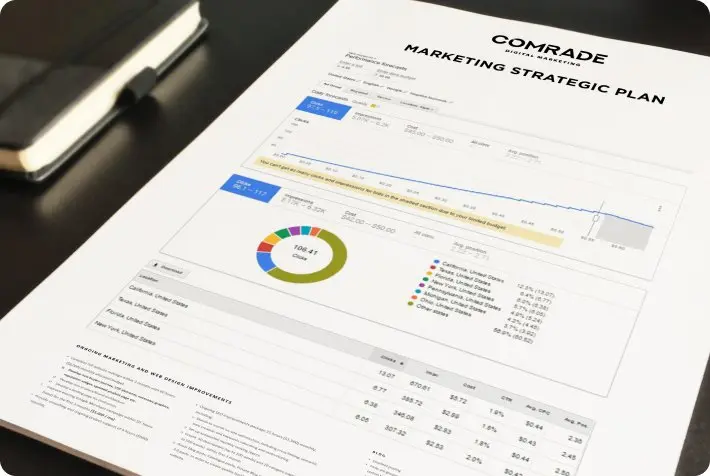Law firms put serious time and money into building their online presence, but even with a sleek website and solid traffic, many still face a frustrating problem: visitors aren’t turning into clients.
It’s not always a question of design or content. Often, it comes down to how well the site is built to convert. And for most law firms, the numbers aren’t great. The average legal website converts just 2.35% of visitors. That means almost 98 out of every 100 potential clients leave without making contact, only to end up hiring someone else.
The good news? With the right strategy, that trend can be reversed.
This guide breaks down eight battle-tested conversion rate optimization (CRO) techniques specifically for law firms. Whether the goal is more consultations, more phone calls, or more qualified leads, these strategies are designed to turn website visitors into real clients.

Why Conversion Rate Optimization Matters More Than Ever for Law Firms
Picture this: A potential client gets rear-ended at a stoplight. They’re hurt, confused, and searching for “personal injury lawyer near me” on their phone in the ER waiting room.
They land on your website. But your contact form has 15 fields. Your phone number is buried in the footer. And your site takes 8 seconds to load.
Guess what happens next? They hit the back button and call the firm whose site made it easy. You just lost a case worth potentially hundreds of thousands in fees, all because of a few fixable website issues.
The Real Cost of Poor Conversion Rates
Let’s do some quick math that might make you queasy:
- Average personal injury case value: $50,000 in fees
- Monthly website visitors: 1,000
- Current conversion rate: 2%
- Leads generated: 20
- Cases won from those leads: 5
Now, imagine boosting that conversion rate to just 4%. That’s 40 leads, 10 cases, and an extra $250,000 in revenue — from the same traffic you’re already getting.
Today’s Legal Clients Expect Amazon-Level Experiences
Modern clients don’t have patience for clunky websites. They’ve been trained by Amazon, Netflix, and Uber to expect:
- Instant answers to their questions
- One-click actions
- Mobile-perfect experiences
- Clear next steps
If your law firm’s website feels like it’s stuck in 2010, you’re not just looking outdated — you’re actively pushing money out the door.
CRO Is Your Competitive Edge
While your competitors dump money into more ads and higher PPC bids, smart firms are quietly doubling their leads by optimizing what they already have. It’s like renovating your existing office to fit twice as many clients instead of paying rent on a second location.
1. Fine-Tune Your Website for Speed, UX, and SEO Impact
Your lawyer website is your firm’s digital front door. And if that door takes forever to open, squeaks on its hinges, or confuses visitors about how to enter, they’ll turn around and knock on someone else’s door instead.
Speed Kills (Or Saves) Conversions
Here’s a sobering stat: 53% of visitors abandon sites that take more than 3 seconds to load. For law firms, where every visitor could be worth thousands in fees, that lag time is costing you cases.
To turbocharge your site speed:
- Compress those hero images and team photos
- Ditch auto-playing videos (they’re not impressing anyone)
- Invest in quality hosting — shared hosting is a conversion killer
- Minimize plugins and widgets that slow things down
Mobile Optimization Isn’t Optional — It’s Mandatory
Over 60% of local searches happen on mobile devices. When someone’s been in an accident or needs urgent legal help, they’re not firing up their desktop — they’re frantically searching from their phone.
Your mobile site needs:
- Thumb-friendly buttons and forms
- Click-to-call functionality front and center
- Readable text without pinching and zooming
- Forms that don’t require microscopic precision to complete
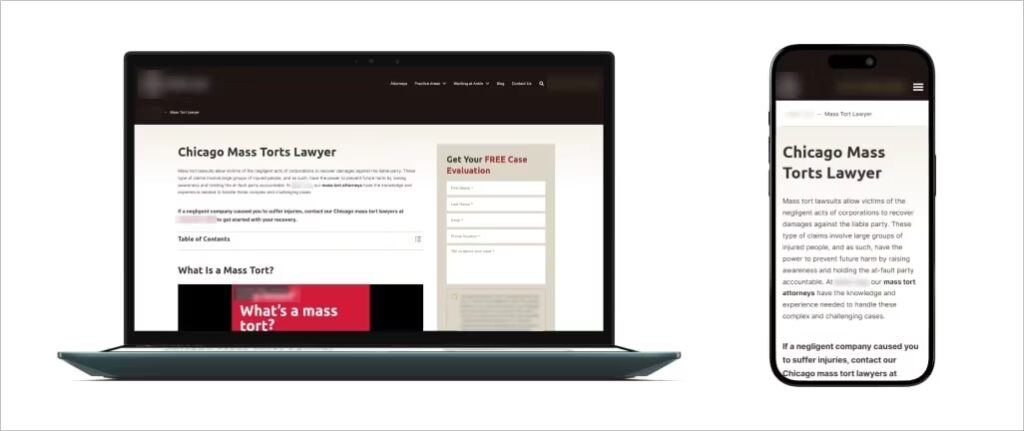
Create Clear Pathways to Contact
Stop making potential clients hunt for ways to reach you. Your contact options should be:
- Visible on every single page
- Repeated in multiple formats (phone, form, chat)
- Positioned where stressed, anxious visitors expect them
- Working flawlessly across all devices
The SEO-CRO Connection
Here’s what many firms miss: Better user experience signals to Google that your site deserves higher rankings. When visitors stay longer, engage more, and convert better, search engines take notice. It’s a beautiful cycle — better CRO leads to better SEO, which brings more traffic to convert.
Pro tip: Use tools like Google PageSpeed Insights and GTmetrix to identify specific speed bottlenecks. Even shaving one second off your load time can boost conversions by 7% or more.
2. Redesign Landing Pages for Maximum Conversion Impact
Your landing pages on your solo law firm website are where the rubber truly meets the road. They’re more than just pages — they’re precision-engineered conversion machines built to transform anxious searchers into confident callers.
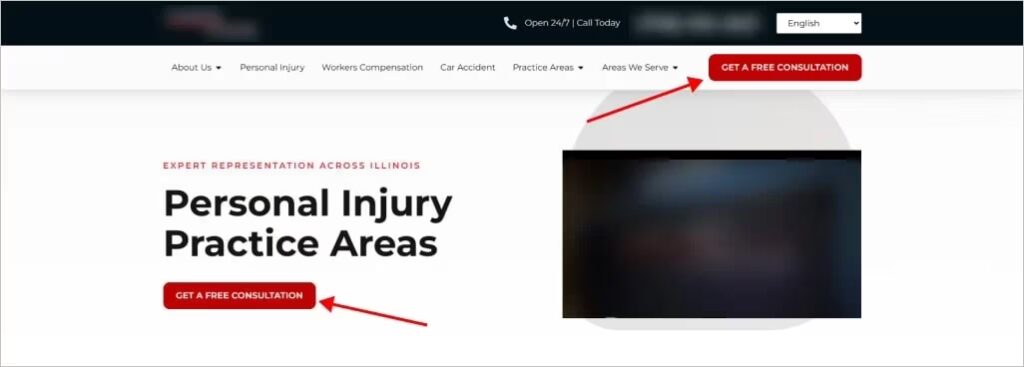
One Service, One Page, One Purpose
Generic “practice areas” pages are conversion killers. Someone searching for “wrongful death attorney” doesn’t want to land on a page that also covers speeding tickets and contract disputes.
Create dedicated landing pages for each service that:
- Address that specific legal issue in depth
- Speak to the exact pain points of that situation
- Include relevant case results and testimonials
- Feature a single, focused call-to-action
Headlines That Stop Scrollers Cold
You’ve got just 8 seconds—make them count. Your headline should instantly reflect what your audience is searching for, offer a clear solution to their problem, and show you’re the real deal.
Forget bland intros like “Welcome to Smith & Associates Law Firm.”
Go with something like: “Chicago Medical Malpractice Lawyers Who’ve Recovered $50M+ for Injured Patients.”
It’s direct, relevant, and instantly builds trust.
Trust Elements That Overcome Skepticism
Let’s be honest — people don’t trust lawyers. Your landing page needs to overcome that skepticism fast with:
- Specific case results: “$2.3M settlement for construction accident” beats “Millions recovered”
- Real testimonials: Video testimonials crush written ones
- Credentials that matter: Board certifications, years of experience, trial wins
- Awards and recognition: But only the ones that clients care about
Remove Every Ounce of Friction
Every extra click, confusing element, or unnecessary field is a conversion killer. Ruthlessly eliminate:
- Navigation menus that lead visitors away
- Sidebar widgets that distract
- Multiple competing CTAs
- Any content that doesn’t directly support conversion
Remember: A confused mind doesn’t convert. Your landing page should have one goal and make it impossibly easy to achieve.
3. Write Messaging That Speaks Directly to Your Ideal Clients
Your potential clients aren’t browsing your website like it’s a law journal. They’re anxious, overwhelmed, and looking for a lawyer who truly understands their situation. If your content sounds robotic or overly formal, you’re driving them straight to your competitors. That’s why effective content marketing for lawyers is essential—to connect authentically and build trust from the first word.
Ditch the Legal Dictionary
Nobody searching for help after a car crash wants to read about “tortious conduct” or “proximate causation.” They want to know:
- Will I have to pay anything upfront?
- How long will this take?
- What’s my case actually worth?
- Can you really help me?
Write like you’re explaining things to a stressed friend, not arguing before the Supreme Court.
Focus on Benefits, Not Features
Your clients don’t care that you have 30 years of experience. They care what those 30 years can do for them.
Instead of: “Our firm has extensive experience in personal injury litigation”
Try: “We’ve helped 1,000+ accident victims get the money they deserved — without going to court”
Address Their Real Fears Head-On
Your messaging should tackle the concerns keeping them up at night:
- “No, you won’t owe us anything unless we win”
- “Yes, we handle all the paperwork while you focus on healing”
- “Most cases settle in 6-12 months — here’s what to expect”
- “Insurance companies hate us because we don’t back down”

Use Their Words, Not Yours
Listen to how clients describe their situations on intake calls. Those exact phrases should be all over your website. If they say “The insurance company is giving me the runaround,” don’t translate that to “experiencing claim processing delays.”
AI-Powered Tip: Use tools like Copy.ai or Jasper to help transform stiff legal language into conversational, benefit-driven copy. But always review for accuracy and add your firm’s unique voice.
4. Use Chatbots to Qualify Leads and Answer FAQs Instantly
That potential client visiting your site at 11 PM after a traumatic accident? They won’t wait until Monday morning for answers. If you’re not available around the clock, your chatbot better be—because effective SEM for law firms means capturing those urgent leads whenever they come.
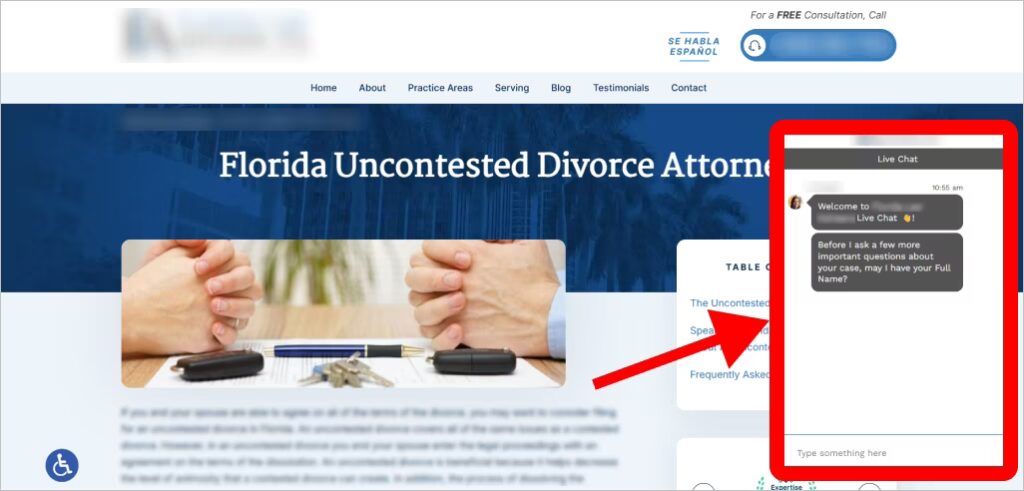
Instant Engagement Captures Hot Leads
Forget those clunky 2015 pop-ups—today’s AI chatbots are a whole new game. They greet visitors instantly, ask the right questions like a human would, and even book consultations while you sleep. Urgent leads? Sent straight to the right attorney. And even if someone bounces, their contact info doesn’t. With conversion boosts up to 23%, smart firms are letting their chatbot do the heavy lifting.
Answer the Questions That Can’t Wait
Program your chatbot to handle the urgent questions that bring people to your site:
- “Do I have a case?”
- “How much will this cost?”
- “What should I do right now?”
- “How long do I have to file?”
Each answer should be helpful enough to build trust but compelling enough to encourage real contact.
Qualify While You Sleep
Smart chatbots don’t just chat — they qualify. By asking the right questions, they can:
- Determine case type and value
- Check the statute of limitations
- Assess the urgency level
- Gather key facts for your intake team
When you arrive Monday morning, you’re not sorting through random inquiries — you’re reviewing pre-qualified, high-value leads.
The Human Touch Still Matters
Your chatbot should enhance, not replace, human connection. Best practices include:
- Clear escalation to real people for complex issues
- Transparent disclosure that it’s a bot
- Personality that matches your firm’s brand
- Regular updates based on common questions
Pro Implementation Tip: Start with tools like Intercom, Drift, or Qualified. Most integrate seamlessly with your CRM and can be customized for legal-specific workflows.
5. Continuously Test Page Elements to Improve Performance
Your website isn’t a “set it and forget it” brochure. It’s a living, breathing conversion engine that needs constant tuning. The difference between a 2% and 4% conversion rate? Often just a button color, a headline tweak, or a form field removed.
A/B Testing: Your Secret Weapon
Stop guessing what works. A/B testing gives you clear, data-backed answers. Test elements like:
- Headlines: “Injured? We Can Help” vs. “Get Maximum Compensation for Your Injuries”
- CTA Buttons: “Free Consultation” vs. “Get Your Free Case Review”
- Form Length: 3 fields vs. 7 fields
- Images: Stock photos vs. real team photos
- Trust Badges: Where to place them for maximum impact
Want to know what works? Let the data decide.
Start With High-Impact Tests
Stop spending time tweaking footer colors—it won’t move the needle. Instead, focus on the elements that drive conversions:
- Your main headline and subheadline
- CTA button text, color, and placement
- Form fields (every field you remove can boost conversions by 5-10%)
- Phone number visibility and click-to-call functionality
- Live chat timing and triggers
Conversion gains come from smart, strategic tweaks, not cosmetic ones.
Let Data Drive Decisions
Your opinion doesn’t matter. Your partner’s opinion doesn’t matter. The only opinion that matters is what the data shows. Tools like Google Optimize, Optimizely, or VWO make testing straightforward.
Run each test for at least 2-4 weeks to ensure statistical significance. One fluke week shouldn’t dictate your entire strategy.
Test Beyond the Homepage
Most firms obsess over their homepage and ignore where the real conversions happen:
- Service-specific landing pages
- Contact forms
- Thank you pages
- Mobile experiences
- Blog post CTAs
Remember: Even a 0.5% conversion improvement can mean tens of thousands in additional revenue. Keep testing, keep improving, keep growing.
6. Showcase Social Proof to Increase Credibility and Conversions
Potential clients often don’t trust law firms—they trust the experiences of other clients who have been in their shoes. That’s why social proof on lawyer review sites isn’t just a nice-to-have; it’s the credibility oxygen your conversions need to thrive.
Make Your Wins Impossible to Ignore
Vague claims like “Millions Recovered” are meaningless. Get specific:
- “$3.2M – Traumatic Brain Injury from Truck Accident”
- “$750K – Slip and Fall at Local Grocery Store”
- “$1.8M – Medical Malpractice Birth Injury”
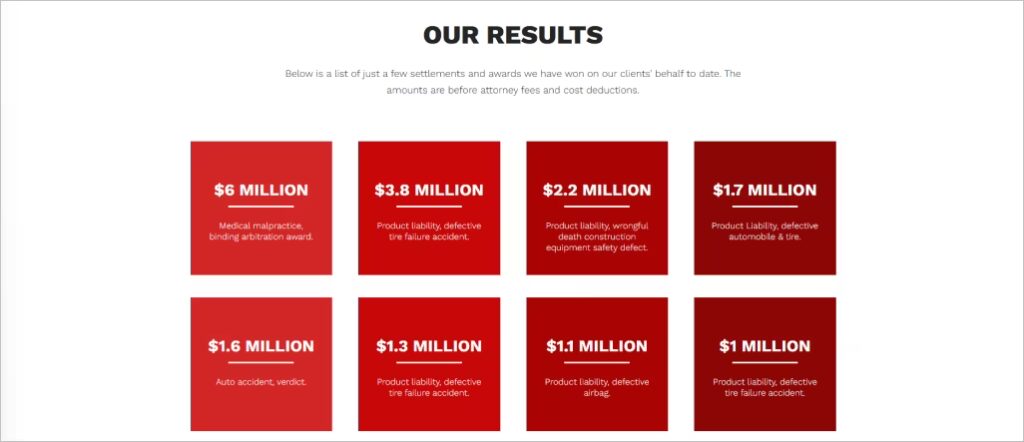
Display these prominently with enough detail to be credible but not so much that you violate confidentiality.
Video Testimonials Are Conversion Gold
Written testimonials are good. Video testimonials are unstoppable. They show:
- Real people with real stories
- Emotional connection and authenticity
- Proof that you deliver results
- The human side of your firm
Even 30-second clips can dramatically boost trust and conversions.
Leverage Every Credibility Marker
Don’t be shy about what you’ve accomplished — show it off!
Share your bar memberships and certifications, mention any media features or quotes that put you in the spotlight, and highlight the articles you’ve written or the events where you’ve spoken.
Make sure to bring up awards that matter to your clients, and let people know how many years you’ve been in the game and the cases you’ve handled. Let your hard work speak for itself!
Reviews: The Modern Word-of-Mouth
Almost everyone—98% of people—checks online reviews before choosing a lawyer.
So, make sure yours shines. Always respond thoughtfully to every review, show off your Google reviews right on your website, and don’t shy away from negative feedback—instead, use it as a chance to show how professional and caring you are.
Also, mix in reviews from different places like Google, Avvo, and Facebook to build real trust with potential clients.
Strategic Placement Multiplies Impact
Where you place social proof matters as much as what you show:
- Near CTAs to overcome last-second hesitation
- On landing pages to build immediate trust
- In sidebars, as visitors scroll
- On thank you pages to reinforce their decision
Pro tip: Use tools like Trustpilot, BirdEye, or ReviewTrackers to manage and display reviews automatically. Fresh social proof keeps your credibility current.
7. Use Short, Clear Forms to Improve Completion Rates
Your contact form is the crucial gateway where interested visitors transform into valuable attorney leads. Yet, too many law firm forms become conversion killers—burdened by unnecessary fields, confusing layouts, and friction that drive potential clients away. Effective attorney lead generation starts with a seamless, user-friendly form designed to capture and convert.
The Golden Rule: Less Is More
Every additional form field reduces conversions by 5-10%. That “How did you hear about us?” field? It just cost you a client. Strip your forms down to the absolute essentials:
- Name
- Phone number
- Brief case description (optional)
That’s it. You can gather everything else during the consultation.
Make It Effortless on Mobile
Most of your visitors are on their phones—often anxious, rushed, or distracted. That’s why your form needs to feel effortless. Use big, easy-to-tap fields and keep everything in a simple, single column so it scrolls naturally.
Let the form guide users by automatically moving them to the next step, and make sure inputs feel right, like showing a number pad for phone fields. And if something goes wrong, offer kind, helpful error messages that support instead of blame. Make every interaction feel smooth and stress-free.
Remove Psychological Barriers
Tiny changes can lead to huge improvements in conversions—seriously. Instead of using cold, robotic buttons like “Submit,” try something more inviting like “Get Your Free Case Review.” It instantly feels more personal.
Add a simple line like “100% Confidential – No Obligation” to ease doubts and show you’re on their side. If your form has multiple steps, let users know how far along they are with a progress bar—it makes things feel quicker and less overwhelming.
Whenever you can, pre-fill information to save them time and effort. And unless captchas are critical, ditch them—they just frustrate people and kill momentum.
Smart Form Features That Convert
Modern form tools offer conversion-boosting features:
- Conditional logic: Show relevant fields based on case type
- Save and resume: Let stressed visitors come back later
- Real-time validation: Catch errors before frustration builds
- Smart defaults: Auto-detect location, format phone numbers
Test, Measure, Optimize
Track your form analytics religiously:
- Where do people abandon?
- Which fields cause hesitation?
- How does mobile compare to desktop?
- What’s your form-to-lead conversion rate?
A/B test everything: field order, button text, form length, and design. Even tiny improvements compound into massive results.
Implementation tip: Tools like Typeform, JotForm, or Gravity Forms offer advanced features while integrating with your CRM. Don’t settle for basic contact forms when smart forms can double your conversions.
8. Re-Engage Visitors with Smart Retargeting Campaigns
Here’s the tough truth: 96% of people who visit your law firm’s website leave without reaching out. Not because they don’t need help — they’re just not ready yet. That’s where smart retargeting comes in. It keeps you on their radar, so when the time is right, they come back to you. Even better, it supports important Google ranking factors for lawyers by keeping your site active and engaging.
Strike While the Iron’s Warm
Someone who spent 5 minutes reading about wrongful death cases isn’t casually browsing. They’re processing trauma and gathering courage. Retargeting keeps you top-of-mind during their decision journey.
Set up campaigns that:
- Show different messages based on the pages visited
- Increase urgency as the statute of limitations approaches
- Highlight different benefits (free consultation vs. no upfront fees)
- Feature testimonials from similar cases
Exit-Intent Popups: Your Last Shot
When someone’s mouse heads for that back button, you have one final chance. Make it count with exit-intent offers:
- “Wait! Download our free accident checklist”
- “Leaving? Get a free case evaluation by email”
- “Not ready to call? Chat with us instead”
- “Save this page for later” (with email capture)
These can recover 10-15% of abandoning visitors when done right.
Email Nurture Sequences That Convert
Not everyone’s ready to hire immediately. Nurture sequences keep you connected:
- Immediate: “Thanks for visiting – here’s what to do next”
- Day 3: Educational content about their legal situation
- Week 1: Case study similar to theirs
- Week 2: Deadline reminders and urgency
- Week 3: Final offer with exclusive consultation
Retargeting Best Practices for Law Firms
To run campaigns that are both ethical and effective, keep your ads to a gentle 3-5 times per day, so you don’t overwhelm people. Quickly exclude anyone who’s already converted, and use burn pixels to avoid bothering those who’ve chosen another firm. Always keep your message professional and helpful, showing respect for sensitive situations with a thoughtful, genuine tone—never pushy or aggressive.
Platform Strategy That Works
Diversify your retargeting across channels:
- Google Ads: For search-intent remarketing
- Facebook/Instagram: For visual storytelling and testimonials
- LinkedIn: For commercial and business litigation
- YouTube: For educational video content
Remember: Someone who’s visited your site has already shown interest. Retargeting isn’t pestering — it’s providing helpful reminders when they’re ready to act.
The Verdict: Your Website Is Costing You Cases
Turning your website visitors into loyal clients can completely transform your law firm’s growth. When you know exactly what your audience needs, pair that with a user-friendly website, and add clear, compelling calls to action, you’ll see more inquiries and cases coming through the door.
At Comrade Digital Marketing Agency, we’re experts in helping lawyers like you stand out online. We understand the unique challenges law firms face and create personalized strategies designed to attract the right clients and grow your practice sustainably.
Working with us means having a dedicated partner who genuinely cares about your success. We combine data-driven insights with creative solutions to make sure your marketing efforts actually deliver results, not just empty clicks.
If you’re ready to stop leaving potential clients behind and start turning your online presence into a powerful tool for growth, let’s connect. Book a consultation with Comrade Digital Marketing Agency today, and let’s make your firm’s future brighter together.
Frequently Asked Questions
-
What are some tools that can help with CRO for law firms?
Law firms can use tools like Google Analytics to track user behavior, Hotjar for heatmaps, and Optimizely for A/B testing. These tools provide valuable insights to improve conversion optimization efforts and help law firms better engage prospective clients.
-
Can law firms achieve good results with a small budget?
Yes, even with a small budget, law firms can see strong results by focusing on their target audience and offering clearly defined legal services. A focused digital marketing strategy that includes thoughtful content and basic CRO tools can lead to meaningful improvements.
-
How much should a law firm budget for Conversion Rate Optimization (CRO)?
In the legal industry, law firms typically budget around $1,000 to $5,000 per month for CRO, depending on their size and goals. Investing in successful conversion rate optimization boosts client acquisition by turning more visitors into leads. Keeping a steady CRO budget helps improve the law firm’s conversion rates and gets more value from existing traffic instead of just chasing new prospects.
